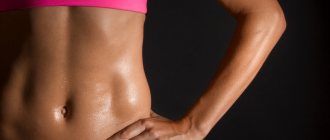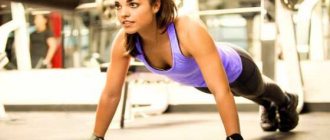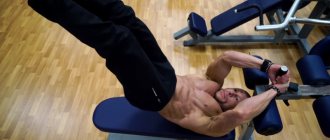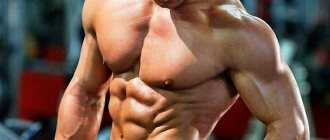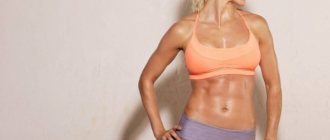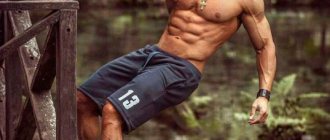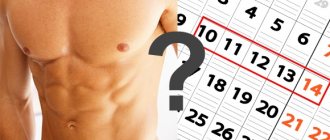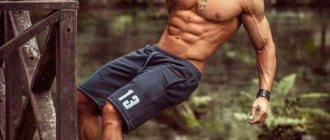Greetings to all! Today we will talk about the abdominal muscles. Namely about the lower press. A flat stomach with cubes is beautiful and sexy. Inflated abs radically change your appearance and perform important functions in maintaining overall health.
Pumping the area in the lower abdomen is more difficult. Any exercise affects the abs completely. Only the degree of stress of different parts differs depending on the selected load case. Effective exercises for the lower abs help to quickly give the ideal shape to the lower abdomen for both men and women.
Anatomy of the abdominal muscles
The abs are the core muscles or stabilizers. They are not designed to move bones. The press keeps the spine, pelvis, and hips in a stable position. The muscular frame of the abdomen protects, supports internal organs, and helps proper digestion.
Vast abdominal muscles
They lie in three layers:
- Transverse (located inside to support organs).
- Internal oblique (continues the internal intercostal).
- External oblique (continues the external intercostal oblique).
Rectus muscle
The paired flat muscle stretches from the pelvis to the sternum. At the pubis it is much narrower than at the chest. Two parallel longitudinal parts are separated by a white line. They are crossed by connective fibers. Thanks to them, a pattern in the form of cubes appears. With severe weight loss, the cubes are also visible.
Why is it important to train your lower abs?
Sagging belly is a problem for many people. Healthy eating and fitness will eliminate this deficiency.
During physical activity, the rectus muscle tenses unequally. Most of the effort falls on its upper part. Fat in the lower abdomen accumulates faster and is more difficult to lose.
You can solve the problem by specifically selecting exercises for the desired part of the abs. But it won’t be possible without losing weight. Fat cannot be removed by pumping.
Contraindications to training
Many men and women want to have a great appearance. But not everyone is recommended to actively pump up their abs. Some people need to limit themselves to diet, as well as lighter physical activity.
Contraindications to exercises:
- Postoperative period.
- Presence of a hernia.
- Problems with the spine.
- For girls and women, abdominal exercises are not recommended during menstrual periods.
If you have doubts that fitness classes can harm your health or worsen your well-being, you should consult a doctor for advice.
Press exercises. 30 best abdominal exercises - for the upper and lower abdominal muscles
Your complete guide to ab exercises.
All athletes, whether hockey players, baseball players or football players, strengthen their abdominal muscles by performing basic exercises. This is great for professional athletes, but what about the guys and gals who just want to tone their abs and see that coveted 6-pack? How can they find the most effective abdominal exercises to see six-pack abs? Or maybe the secret to a flat stomach lies elsewhere?
First, let's face it: everyone's abdominal muscle structure is different, and most importantly, everyone's amount of subcutaneous fat and metabolism are different. Some guys have to work out to the point of exhaustion before their abs become ripped, while others seem to have a six-pack appearing without much effort.
Regardless of which group you belong to, effective abdominal exercises for training in the gym or at home come down to movements in three planes: frontal, sagittal and transverse. By doing abdominal exercises in cycles, you'll keep your workout intensity high and are likely to burn more fat.
.
Roll-outs with a gymnastic roller
Get on your knees and hold the roller on the floor directly under your shoulders. Tighten your abdominal muscles and roll the roller forward until you feel tension in your core muscles. The hips should not sag. Roll the roller back to return to its original position. Do as many repetitions as possible, maintaining the correct technique for performing the exercise.
Partial torso raises with raised arms
Lie on your back, bend your legs at an angle of 90°, straighten your arms and lift them up. Keep your arms in this position throughout the entire exercise. Perform a partial lift of the torso, and then slowly return to the starting position. These movements constitute one repetition.
Rollouts with a barbell
Place 5kg weight plates on the bar and kneel down. Shoulders should be above the bar. Tighten your abdominal muscles and roll the barbell forward until you feel your hips begin to sag. Return to the starting position.
Russian twist with barbell
Grasp the bar with both hands almost at the very end. Feet shoulder width apart. Rotate the bar to the left, moving your feet as necessary, and then rotate to the right.
Crunches on a fitball
Lie with your back on the ball, place your feet on the floor and place them shoulder-width apart. The ball should support your lower back. Place your hands behind your head, pull your chin back. Lift your torso up until you are in a sitting position.
Leg raises on parallel bars
Take an emphasis on the uneven bars. Bend your knees slightly and then lift them in front of you until they are parallel to the floor.
Lying leg raise
Lie on your back, straighten your legs, place your arms along your body. Lift your heels off the floor and lift them to a height of about 15 cm. At a fast pace, alternately lift your legs up and down (scissor style).
Front Squats
Place the barbell on a power rack at approximately shoulder height (if there is no power rack, then grab the barbell from the floor to your chest). Grasp the bar with a shoulder-width grip. Raise your elbows up until your shoulders are parallel to the floor. Remove the barbell from the racks and support it with your fingertips. As long as your elbows are raised, you will be able to hold the barbell. Take a step back, place your feet shoulder-width apart, and point your toes slightly outward. Squat down as low as possible, maintaining a arch in your lower back.
Lumberjack exercise
Place the handle of the machine at shoulder height (or attach the resistance band to a stable object) and grasp it with both hands. Stand with your side to the handle, spread your feet shoulder-width apart, straighten your arms. Stand far enough away from the machine to create tension in the cable. Turn your body away from the machine in a movement as if you were cutting down a tree. The legs must remain motionless.
Lying leg raise
Lie on the floor and grab a bench or the legs of a heavy chair for support. Straighten your legs and lift them up to a vertical position. Lower your legs down, but don't place them on the floor, to maintain tension in your abdominal muscles before starting the next rep.
Example workout
A small complex for independent implementation, which is suitable for women as well as men.
- Lie on your back and place your palms under your head. First, raise your right leg to a right angle, and then your left. Stay in this position for a short time. Then slowly lower one, then the other leg.
- Lie on your back, raise your head. Place your hands on the back of your head. Raise your extended legs a little too. Now move your legs up and down alternately as if you were swimming on your back. The exercise is great for women and girls.
- Lie on your back, then prop yourself up on your elbows. Raise your extended legs slightly above the floor and hold in this position. Without lowering your legs, cross them alternately.
Perform this short routine three times a week. Combined with a healthy diet, it will help improve your appearance.
At home
If you can’t go to the gym and have little time to exercise, then you can do the exercises at home. Let me give you a few examples.
- Reverse crunches.
Lie on the floor, raise your head slightly. Bend your legs, then lift them at a right angle. Now pull your knees towards your chest as close as possible. Then lower your legs.
- Raised leg extension.
Lie on your back and raise your legs straight at a right angle. Now spread your legs and hold for a little while. Then connect them. Then lower it slowly.
- Exercise with a roller.
The roller is ideal for home use. I advise beginners to practice with their knees on the floor. This option is also suitable for girls and women. It is more difficult to perform loads while leaning on your toes. The body must be positioned parallel to the floor. You need to pull the roller towards you with your hands, and then roll it away from you.
In the gym
Working out in the gym brings more benefits. In addition to the exercise equipment, the gym has a special atmosphere that motivates beginners to engage in physical activity and not to slack off. Well, I’ll now tell you about some popular exercises on exercise machines for the lower abs.
- Hanging leg raises.
It uses a simulator with special soft armrests. Place your forearms on the armrests and press your back against the wall. Now slowly begin to raise your legs. They need to be raised a little higher than a right angle. Stay in this position and then lower your legs. Beginners are advised to bend their legs at the knees. For experienced male athletes, the Swedish wall and horizontal bar are suitable.
- Exercises on an incline bench.
Lie down on a bench with your feet down. Bend your legs slightly and slowly raise them and then lower them (but not all the way). Your back should be pressed tightly against the bench. The pelvis lifts slightly from the surface. If you place the bench at a greater angle, the tension will increase. For men, you can hold a dumbbell between your ankles for weights.
- Exercises with fitball.
A large gymnastic ball is a wonderful sports equipment. Here is one of the exercises. Lie on your back on the fitball. Place your knees bent on the floor at an angle of 90 degrees. Place your hands on the back of your head. Do a twist, lifting your body up.
HOW TO PUMP UP YOUR PRESS
+2
What people most often think of when they talk about developed abs is called the RECTUS ABDOMINUS MUSCLE
.
In addition to this muscle, there are also EXTERNAL OLIQUE MUSCLES
and
INTERNAL OLIQUE MUSCLES
of the abdomen. The first ones are very clearly visible in lean people - the external oblique muscles stretch diagonally from the armpits to the lower abdomen. Visually, they look like scratches left by a tiger scratching the side of a fleeing victim. We will not consider the internal oblique muscles, because they are not visible. located under the external oblique muscles.
Rectus abdominis muscle
we actually call it the press, because it is this that lines the outer wall of the peritoneum.
It is a flat and long muscle that is divided into two halves (left and right) by a vertical line of tendons (“linea alba”). This line is nothing more than a bundle of tendons 1.5 to 2 cm wide, which starts from the pubic bone at the bottom and stretches along the abdomen up to the sternum. It must be said that this bundle of tendons is not the only one. There are several more bundles that cross the rectus abdominis muscle perpendicular to the direction of its fibers. Actually, thanks to one vertical bundle of tendons and several horizontal ones, we see those same cubes (squares) on the embossed abdomen that form such a tempting “washboard” of your abs.
Understanding these basic things can greatly simplify your task of pumping up your abs. First of all, since we are dealing with one main muscle (rectus abdominis), and not with several different ones, it becomes clear that it cannot work in parts, but will always work only as a whole
. This is a very important point that has practical significance for training any muscle. When you contract any muscle, such as your biceps (put a cup of tea to your lips), you contract the entire biceps, not just the lower or upper part. The same thing happens with the press.
Often trainers in fitness gyms talk nonsense about the fact that you can pump up the lower part of the abs separately from the upper part. Remember once and for all : There are no exercises in nature that would load only part of a certain muscle. The press either contracts or relaxes ENTIRELY.
If we change the vector and angle of the load, then formally we can shift the emphasis a little. But for you, if you are not a competitive bodybuilder, this information is useless, because the difference in the top-bottom accents will be no more than 1-3%.
Such a difference, as they say, makes it neither cold nor hot.
You won't feel it. The rectus abdominis muscle (abs), despite the fact that because of the squares it seems to you that it is several muscles, is actually one muscle and it physically cannot contract only in the places you want.
Why does the lower abs always lag behind the upper ones?
Why then does the lower press always lag behind the upper? Working out and developing the lower abs is not a simple matter for two reasons (if you are a man) and for three reasons (if you are a woman):
- There's not much to train there
. The fact is that the rectus abdominis muscle (abs) is thick only from the waist (navel) and above. And at the point of attachment to the pubic bone, this muscle is very thin and formed mainly by connective tissue. - Based on the size and anatomy of the rectus muscle (abs), the upper portion is thicker, stronger, and therefore does most of the work
of twisting and supporting the core. - If you are a woman, then once a month you experience pain in the lower abdomen. This is the reason for the development of a specific adaptation of the body - nerve sensitivity in the lower abdomen is reduced
so that you do not experience severe pain every month. The negative point is that your lower abdomen is weakly susceptible to stress (weak and flaccid) due to the reduced number of nerve endings.
WHAT TO DO SO THAT THE PRESS IS VISIBLE?
In order for our abs to look like a million dollars, we need to solve two problems. We need to increase the size of the rectus abdominis muscle and we need to reduce the fat content in that area.
TASKS
- Increase the size of the abdominal muscle (rectus abdominis).
- Reduce fat content so that your abs are visible.
Now we won’t delve deeply into the particulars of fat burning around the abs. Let us only note that the breakdown of fat is essentially a chemical reaction.
(breakdown of triglycerides to fatty acids).
Therefore, fat cannot be “crushed,” “shaken,” “melted,” or “squeezed” out of the fat cell
. All physiotherapeutic procedures - massage, sauna, etc. - in order to lose weight, solve one single problem - to activate blood flow in fatty tissues and improve microcirculation in muscles. BUT it DOES NOT BURN FAT, no matter what massage parlor administrators tell you.
EXERCISES FOR PRESS TRAINING
It is very easy to choose effective exercises for training your abs. Simply because we are not talking about a large muscle group, but about one single rectus abdominis muscle. Which performs a very simple function: twists the pelvis to the body or twists the body to the pelvis
.
The main function of the abs: this muscle “brings” the upper body and lower body (pelvis) closer to each other
.
It's like a book open in the middle - you can close it in two ways: either slam the left half or the right half. Likewise, the press pulls the lower part (abs) towards the body, or pulls the upper part towards the pelvis . The main functions of the rectus abdominis muscle:
- Twists (pulls) the top of the body to the bottom (pelvis).
- Twists the lower body (pelvis) towards the upper body.
Hundreds of existing ab exercises inherently use one of these functions. Therefore, we need to choose those exercises that maximally concentrate the load on one of the above-mentioned movement vectors.
The two main exercises for training your abdominal muscles are LYING CROWS.
and
REVERSE CROWS
.
LYING TURNS.
Basic exercises for developing abdominal muscles.
If you only have time to do one exercise, then lying down crunches are your best choice. As a matter of fact, the abs can be well developed using just this one exercise, because it will allow you to contract the rectus abdominis muscle as efficiently as possible
. Crunches are performed lying on the floor, on a Roman chair or on an inclined board. The lower your body and head are relative to your hips (Roman chair, or downward sloping board), the more difficult it is for you to do lying crunches due to the lengthening of the amplitude and increasing the load at the bottom.
Mechanical ways to complicate the load in this exercise.
- Leg position.
Elevated bent legs are the easiest form. Bent legs on the floor are a more complex form of crunches. The farther your heels are from your buttocks while lying on the floor, the more difficult it is to perform the exercise. - Hand position.
The closer your hands are to your stomach, the easier it is to twist. The farther your hands are (behind the ears, back of the head, or even further), the more difficult it is to perform the exercise. - Surface slope.
The lower the head is relative to the pelvis, the more difficult it is to perform crunches while lying down.
REVERSE CROWS.
An “inverted” version of the usual lying crunches, because this exercise twists the lower body (pelvis) in relation to the upper body. Therefore, it is often said that these are exercises for the “lower” abs. There are dozens of reverse twist options. You can lift your legs or knees up while lying down, or, for example, you can, while hanging on a horizontal bar, lift your legs up towards your head (yes, yes, these are all types of reverse crunches).
Starting position , lie on the floor so that you have support for your hands next to your forehead. This is necessary so that you can fix your upper body and perform twists only by moving your hips up
.
IMPORTANT: the goal is to lift (twist) the pelvis upward! Not the legs, but the pelvis. Trainers often advise raising your legs towards your body. This is mistake. The press does not lift the legs. The function of the press is to raise the pelvis. It’s just that when you raise your legs, your pelvis is forced to rise to some extent. BUT...why load the press with an indirect load if it is possible to load it with an accented one? While lying on the floor, do not think about your legs at all (you can bend them at the knees to lighten the load), but think about how to lift your pelvis from the surface of the floor.
Reverse crunches, as you understand, can be done in easier or more complex forms, just like regular crunches. Here are the main ideas:
- Leg position.
The more your legs are bent at the knees and closer to the chest, the easier it is to do reverse crunches. The more the legs are straightened and the heels are further from the pelvis, the more difficult it is to do this exercise. - Surface slope.
The higher your chest and head are relative to your pelvis (lie on an incline bench), the more difficult it is to do reverse crunches due to the greater amplitude and load. The lower the body is to the pelvis, the easier it is to do reverse crunches. As a matter of fact, this is why it is most difficult to raise your legs (pelvis) while hanging on the horizontal bar because the body is in the highest possible position relative to the pelvis.
PRESS TRAINING COMPLEX
Most often it is recommended to train the abdominal muscles quite often, motivating this by the fact that the abdominal muscles recover quickly. This may or may not be correct. It all depends on how you train your abdominal muscles.
Let's say you're doing a classic (fast twitch) ab workout. Then you should do 3-4 SETS and aim to reach failure within 20-30 seconds. This interval promotes better hypertrophy of the abdominal muscles. Our amplitude is full, and the load is large. LOAD can be increased with additional acceleration. The faster you do the crunches, the more work and fatigue you get. The sooner the burning sensation and REFUSAL will occur. Rest between sets for 30-60 seconds.
Example 1
- Lying crunches 4 x 20-50 (20-30 sec. Failure).
- Hanging leg raises 4 x 6-12.
Example 2
- Lifting the pelvis while lying down 4 x 6-12.
- Roman chair crunches 4 x 6-12.
Example 3
- Hanging leg raises 4 x 6-12.
- 4 SERIES: Roman chair crunches (6-12 reps) + lying leg raises (partial reps to failure).
Abdominal training takes very little time. The SET + REST cycle often takes less than one minute. Therefore, if you do two exercises of 4 sets each, you will be able to fit your abs workout into 8 minutes.
Tips for implementation
Any physical activity brings the desired result only if done correctly. There are necessary rituals and rules, without which even the most effective complexes lose their meaning. Below are general recommendations for beginners.
- You can start training two hours after eating. The next time you can eat two hours after training.
- Dedicate the first 20 minutes to aerobic exercise. This could be, for example, jumping or running.
- Technique and proper breathing are more important than quantity. On exhalation - muscle tension, on inhalation - relaxation.
- You need to pump up your abs at least three times a week.
Regular exercise and the right approach to training will definitely give the desired result.
Suitable home equipment
In addition to dumbbells and weights, what can you use at home when doing abdominal exercises for men?
Abdominal exercises for men on a fitball
Fitball. This equipment is good for pumping almost all types of muscles. So you will not regret if you purchase it for your use. Let's look at a couple exercises with an exercise ball.
- Tackles with fitball. Take a lying position, palms in line with your shoulders or slightly wider than your shoulders by 10-15 cm, your back is straight, your stomach is tucked, your feet and shins are on the ball, your feet are in a position away from you. As you exhale, pull your knees toward your chest, twisting your pelvis down. We accept the starting position. Two series of 20-25 repetitions.
- Passing the ball. Lie on your back. Take the ball in your hands. Arms extended back. As you exhale, twist and pass the ball with your hands to your knees and back. Touch the ball to the floor in the starting position. You can bend your knees slightly. Two series of 20-25 repetitions.
Downloading the press with a roller
Wheel or roller. Exercises with this type of equipment provide an effective load on the abdominal muscles.
Beginners should pay attention to designs with one wide wheel or several placed together.
Because it’s easier to practice on such rollers.
Here is an example exercise. Get on your knees. Hands squeeze the handles of the roller. Roll forward and then back. Tighten your abdominal muscles (2 series of 10-15 repetitions).
This technique is not easy.
So, depending on your physical fitness, you can calculate for yourself the number of times for one approach.
Press on the horizontal bar
Horizontal bar. You can find it in any wall bars. Many of my friends have a separate horizontal bar at home, which does not spoil their interior, but only helps to keep the body in shape. According to experts, the following exercise is considered one of the most effective.
Firmly grasp the horizontal bar. While hanging, raise your legs parallel to the floor. Then slowly lower to the starting position. The body should remain motionless (20-25 repetitions).
Sets and reps
When pumping your abs, you need to pay attention to the duration of the effort. The most effective repetitions are done slowly. At the peak of the load, you need to stay tense for a couple of seconds. Trainers recommend paying attention to the burning sensation.
Repeats should be done until the moment when it begins to seem that it is impossible to strain anymore. Based on this, you need to choose the load so that after 20-25 repetitions the moment of failure occurs.
Exercises for the lower and middle abs
Next we will move on to the lower and middle abs. So, exercises for the lower and middle abs for men.
- Reverse crunches. Lie down on the floor. Hands next to your body, palms down. Raise your legs perpendicular to your body. Lift your pelvis off the floor and pull your hips towards your chest. Return to the starting position (4 sets of 15-20 reps).
- Scissors. Lie down on the floor. Hands next to your body, palms down. Raise your legs 10 cm from the floor. Swing your legs wide, as if cutting with scissors. The head should not be elevated (2-3 sets of 40-60 seconds).
- Plank. Take a position, leaning on your elbows and toes... Tighten your abdominal muscles. Stay in this position for 90 seconds. The time depends on your physical fitness and endurance.
- Crunches with arms outstretched. Lie on your back. Legs are bent at the knees. Stretch your arms back as a counterweight. Raise your body. Stretch your chest towards your knees, trying to touch them. Hands should not touch the floor. Perform four series of 20-25 repetitions.
Common mistakes
If a complex is chosen, then it must be performed correctly. There are mistakes that are made automatically. Beginners need to be more careful and avoid mistakes when pumping up the muscle frame.
When lifting your legs, you should always leave your knees slightly bent. In this case, energy should be directed to lifting the pelvis. Then the press will be loaded.
The abdominal muscles contract best when the back is rounded and the chin touches the chest. When a person is in a curl position. This is what you should strive for when doing crunches.
